Environmental Degradation in Coastal Bangladesh: Research Report
VerifiedAdded on 2023/01/17
|24
|10279
|72
Report
AI Summary
This report investigates the pressing issue of environmental degradation in the southeastern coastal area of Bangladesh. The research aims to identify and propose sustainable solutions to mitigate the adverse effects of environmental changes, focusing on ecosystem management. The study outlines specific objectives, including identifying past and current ecosystem trends, developing interventions, and assessing implementation challenges. The report reviews key terminologies such as Ecosystem Services (ES), Environmental Degradation (ED), Ecosystem-based Management (EbM), Nature-based Solutions (NbS), Ecosystem-based Disaster Risk Reduction (Eco-DRR), and Climate Change Adaptation (CCA). A conceptual framework is presented, highlighting factors contributing to environmental degradation and the potential role of government bodies, NGOs, and international organizations in implementing effective interventions. The methodology involves qualitative analysis of various strategies, including ES, NbS, and conventional infrastructure, using primary and secondary data to identify changes and recommend appropriate solutions. The research aims to contribute to the development of sustainable practices to protect the coastal environment and its resources.
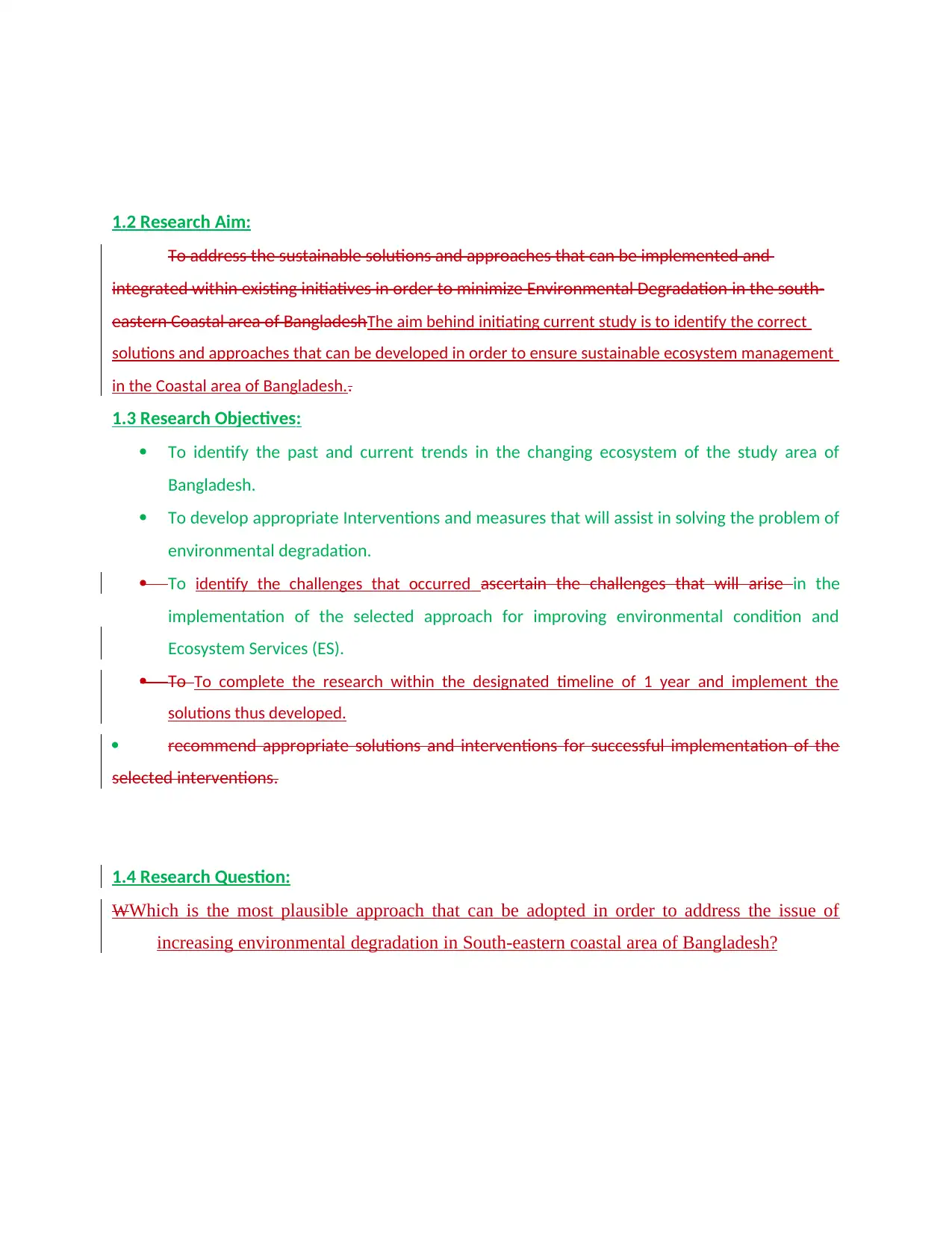
1.2 Research Aim:
To address the sustainable solutions and approaches that can be implemented and
integrated within existing initiatives in order to minimize Environmental Degradation in the south-
eastern Coastal area of BangladeshThe aim behind initiating current study is to identify the correct
solutions and approaches that can be developed in order to ensure sustainable ecosystem management
in the Coastal area of Bangladesh..
1.3 Research Objectives:
To identify the past and current trends in the changing ecosystem of the study area of
Bangladesh.
To develop appropriate Interventions and measures that will assist in solving the problem of
environmental degradation.
To identify the challenges that occurred ascertain the challenges that will arise in the
implementation of the selected approach for improving environmental condition and
Ecosystem Services (ES).
To To complete the research within the designated timeline of 1 year and implement the
solutions thus developed.
recommend appropriate solutions and interventions for successful implementation of the
selected interventions.
1.4 Research Question:
WWhich is the most plausible approach that can be adopted in order to address the issue of
increasing environmental degradation in South-eastern coastal area of Bangladesh?
To address the sustainable solutions and approaches that can be implemented and
integrated within existing initiatives in order to minimize Environmental Degradation in the south-
eastern Coastal area of BangladeshThe aim behind initiating current study is to identify the correct
solutions and approaches that can be developed in order to ensure sustainable ecosystem management
in the Coastal area of Bangladesh..
1.3 Research Objectives:
To identify the past and current trends in the changing ecosystem of the study area of
Bangladesh.
To develop appropriate Interventions and measures that will assist in solving the problem of
environmental degradation.
To identify the challenges that occurred ascertain the challenges that will arise in the
implementation of the selected approach for improving environmental condition and
Ecosystem Services (ES).
To To complete the research within the designated timeline of 1 year and implement the
solutions thus developed.
recommend appropriate solutions and interventions for successful implementation of the
selected interventions.
1.4 Research Question:
WWhich is the most plausible approach that can be adopted in order to address the issue of
increasing environmental degradation in South-eastern coastal area of Bangladesh?
Paraphrase This Document
Need a fresh take? Get an instant paraphrase of this document with our AI Paraphraser
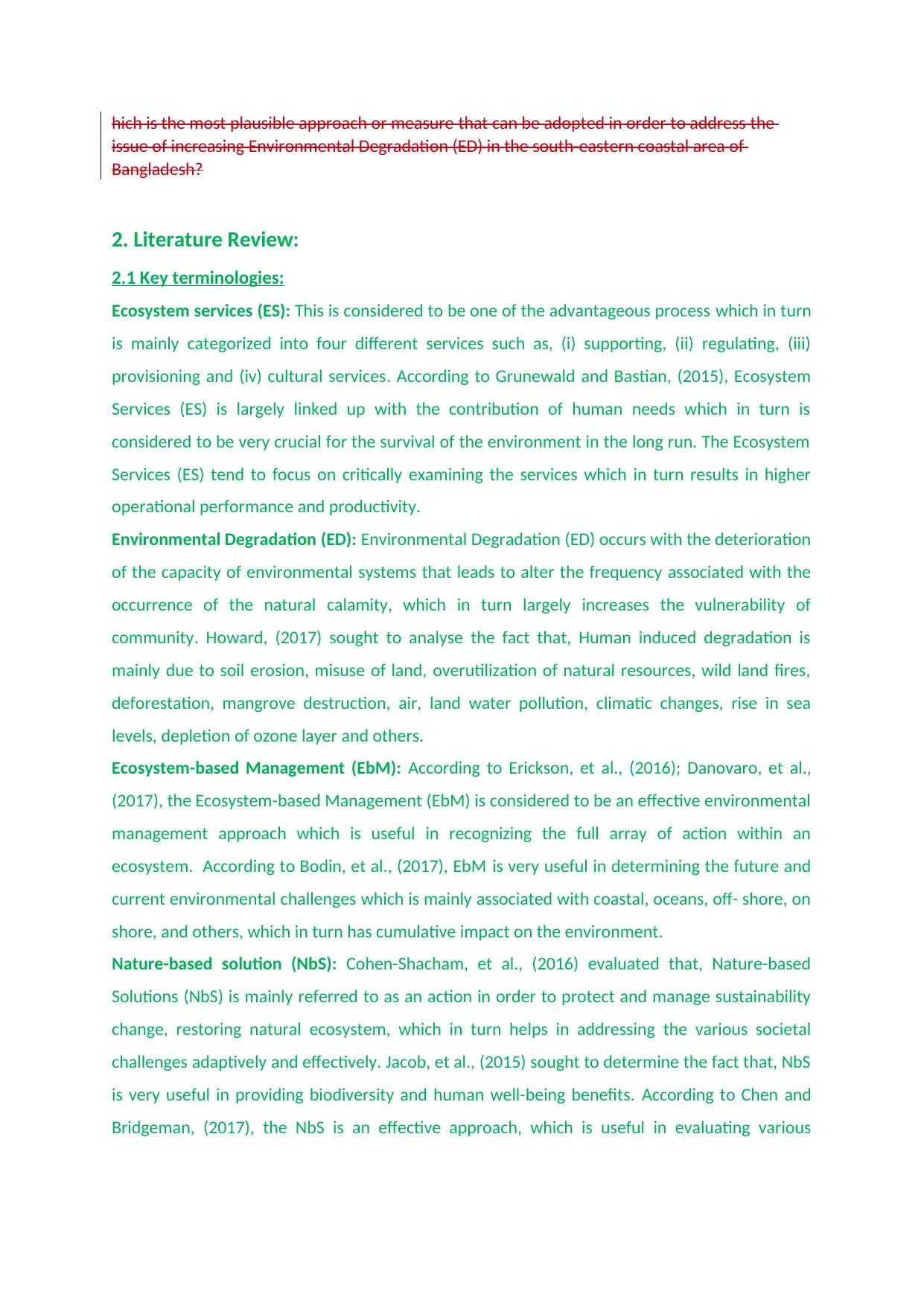
hich is the most plausible approach or measure that can be adopted in order to address the
issue of increasing Environmental Degradation (ED) in the south-eastern coastal area of
Bangladesh?
2. Literature Review:
2.1 Key terminologies:
Ecosystem services (ES): This is considered to be one of the advantageous process which in turn
is mainly categorized into four different services such as, (i) supporting, (ii) regulating, (iii)
provisioning and (iv) cultural services. According to Grunewald and Bastian, (2015), Ecosystem
Services (ES) is largely linked up with the contribution of human needs which in turn is
considered to be very crucial for the survival of the environment in the long run. The Ecosystem
Services (ES) tend to focus on critically examining the services which in turn results in higher
operational performance and productivity.
Environmental Degradation (ED): Environmental Degradation (ED) occurs with the deterioration
of the capacity of environmental systems that leads to alter the frequency associated with the
occurrence of the natural calamity, which in turn largely increases the vulnerability of
community. Howard, (2017) sought to analyse the fact that, Human induced degradation is
mainly due to soil erosion, misuse of land, overutilization of natural resources, wild land fires,
deforestation, mangrove destruction, air, land water pollution, climatic changes, rise in sea
levels, depletion of ozone layer and others.
Ecosystem-based Management (EbM): According to Erickson, et al., (2016); Danovaro, et al.,
(2017), the Ecosystem-based Management (EbM) is considered to be an effective environmental
management approach which is useful in recognizing the full array of action within an
ecosystem. According to Bodin, et al., (2017), EbM is very useful in determining the future and
current environmental challenges which is mainly associated with coastal, oceans, off- shore, on
shore, and others, which in turn has cumulative impact on the environment.
Nature-based solution (NbS): Cohen-Shacham, et al., (2016) evaluated that, Nature-based
Solutions (NbS) is mainly referred to as an action in order to protect and manage sustainability
change, restoring natural ecosystem, which in turn helps in addressing the various societal
challenges adaptively and effectively. Jacob, et al., (2015) sought to determine the fact that, NbS
is very useful in providing biodiversity and human well-being benefits. According to Chen and
Bridgeman, (2017), the NbS is an effective approach, which is useful in evaluating various
issue of increasing Environmental Degradation (ED) in the south-eastern coastal area of
Bangladesh?
2. Literature Review:
2.1 Key terminologies:
Ecosystem services (ES): This is considered to be one of the advantageous process which in turn
is mainly categorized into four different services such as, (i) supporting, (ii) regulating, (iii)
provisioning and (iv) cultural services. According to Grunewald and Bastian, (2015), Ecosystem
Services (ES) is largely linked up with the contribution of human needs which in turn is
considered to be very crucial for the survival of the environment in the long run. The Ecosystem
Services (ES) tend to focus on critically examining the services which in turn results in higher
operational performance and productivity.
Environmental Degradation (ED): Environmental Degradation (ED) occurs with the deterioration
of the capacity of environmental systems that leads to alter the frequency associated with the
occurrence of the natural calamity, which in turn largely increases the vulnerability of
community. Howard, (2017) sought to analyse the fact that, Human induced degradation is
mainly due to soil erosion, misuse of land, overutilization of natural resources, wild land fires,
deforestation, mangrove destruction, air, land water pollution, climatic changes, rise in sea
levels, depletion of ozone layer and others.
Ecosystem-based Management (EbM): According to Erickson, et al., (2016); Danovaro, et al.,
(2017), the Ecosystem-based Management (EbM) is considered to be an effective environmental
management approach which is useful in recognizing the full array of action within an
ecosystem. According to Bodin, et al., (2017), EbM is very useful in determining the future and
current environmental challenges which is mainly associated with coastal, oceans, off- shore, on
shore, and others, which in turn has cumulative impact on the environment.
Nature-based solution (NbS): Cohen-Shacham, et al., (2016) evaluated that, Nature-based
Solutions (NbS) is mainly referred to as an action in order to protect and manage sustainability
change, restoring natural ecosystem, which in turn helps in addressing the various societal
challenges adaptively and effectively. Jacob, et al., (2015) sought to determine the fact that, NbS
is very useful in providing biodiversity and human well-being benefits. According to Chen and
Bridgeman, (2017), the NbS is an effective approach, which is useful in evaluating various
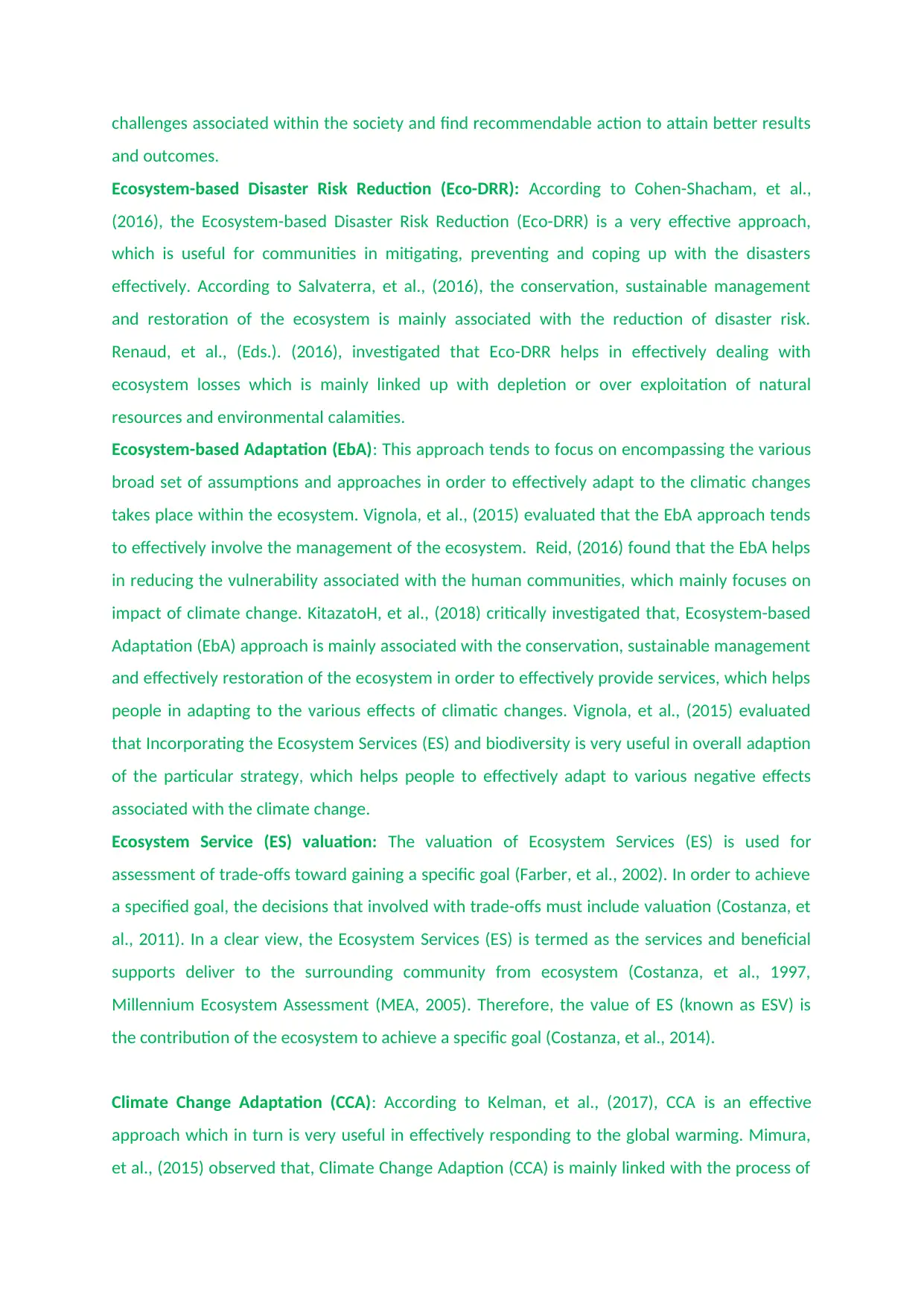
challenges associated within the society and find recommendable action to attain better results
and outcomes.
Ecosystem-based Disaster Risk Reduction (Eco-DRR): According to Cohen-Shacham, et al.,
(2016), the Ecosystem-based Disaster Risk Reduction (Eco-DRR) is a very effective approach,
which is useful for communities in mitigating, preventing and coping up with the disasters
effectively. According to Salvaterra, et al., (2016), the conservation, sustainable management
and restoration of the ecosystem is mainly associated with the reduction of disaster risk.
Renaud, et al., (Eds.). (2016), investigated that Eco-DRR helps in effectively dealing with
ecosystem losses which is mainly linked up with depletion or over exploitation of natural
resources and environmental calamities.
Ecosystem-based Adaptation (EbA): This approach tends to focus on encompassing the various
broad set of assumptions and approaches in order to effectively adapt to the climatic changes
takes place within the ecosystem. Vignola, et al., (2015) evaluated that the EbA approach tends
to effectively involve the management of the ecosystem. Reid, (2016) found that the EbA helps
in reducing the vulnerability associated with the human communities, which mainly focuses on
impact of climate change. KitazatoH, et al., (2018) critically investigated that, Ecosystem-based
Adaptation (EbA) approach is mainly associated with the conservation, sustainable management
and effectively restoration of the ecosystem in order to effectively provide services, which helps
people in adapting to the various effects of climatic changes. Vignola, et al., (2015) evaluated
that Incorporating the Ecosystem Services (ES) and biodiversity is very useful in overall adaption
of the particular strategy, which helps people to effectively adapt to various negative effects
associated with the climate change.
Ecosystem Service (ES) valuation: The valuation of Ecosystem Services (ES) is used for
assessment of trade-offs toward gaining a specific goal (Farber, et al., 2002). In order to achieve
a specified goal, the decisions that involved with trade-offs must include valuation (Costanza, et
al., 2011). In a clear view, the Ecosystem Services (ES) is termed as the services and beneficial
supports deliver to the surrounding community from ecosystem (Costanza, et al., 1997,
Millennium Ecosystem Assessment (MEA, 2005). Therefore, the value of ES (known as ESV) is
the contribution of the ecosystem to achieve a specific goal (Costanza, et al., 2014).
Climate Change Adaptation (CCA): According to Kelman, et al., (2017), CCA is an effective
approach which in turn is very useful in effectively responding to the global warming. Mimura,
et al., (2015) observed that, Climate Change Adaption (CCA) is mainly linked with the process of
and outcomes.
Ecosystem-based Disaster Risk Reduction (Eco-DRR): According to Cohen-Shacham, et al.,
(2016), the Ecosystem-based Disaster Risk Reduction (Eco-DRR) is a very effective approach,
which is useful for communities in mitigating, preventing and coping up with the disasters
effectively. According to Salvaterra, et al., (2016), the conservation, sustainable management
and restoration of the ecosystem is mainly associated with the reduction of disaster risk.
Renaud, et al., (Eds.). (2016), investigated that Eco-DRR helps in effectively dealing with
ecosystem losses which is mainly linked up with depletion or over exploitation of natural
resources and environmental calamities.
Ecosystem-based Adaptation (EbA): This approach tends to focus on encompassing the various
broad set of assumptions and approaches in order to effectively adapt to the climatic changes
takes place within the ecosystem. Vignola, et al., (2015) evaluated that the EbA approach tends
to effectively involve the management of the ecosystem. Reid, (2016) found that the EbA helps
in reducing the vulnerability associated with the human communities, which mainly focuses on
impact of climate change. KitazatoH, et al., (2018) critically investigated that, Ecosystem-based
Adaptation (EbA) approach is mainly associated with the conservation, sustainable management
and effectively restoration of the ecosystem in order to effectively provide services, which helps
people in adapting to the various effects of climatic changes. Vignola, et al., (2015) evaluated
that Incorporating the Ecosystem Services (ES) and biodiversity is very useful in overall adaption
of the particular strategy, which helps people to effectively adapt to various negative effects
associated with the climate change.
Ecosystem Service (ES) valuation: The valuation of Ecosystem Services (ES) is used for
assessment of trade-offs toward gaining a specific goal (Farber, et al., 2002). In order to achieve
a specified goal, the decisions that involved with trade-offs must include valuation (Costanza, et
al., 2011). In a clear view, the Ecosystem Services (ES) is termed as the services and beneficial
supports deliver to the surrounding community from ecosystem (Costanza, et al., 1997,
Millennium Ecosystem Assessment (MEA, 2005). Therefore, the value of ES (known as ESV) is
the contribution of the ecosystem to achieve a specific goal (Costanza, et al., 2014).
Climate Change Adaptation (CCA): According to Kelman, et al., (2017), CCA is an effective
approach which in turn is very useful in effectively responding to the global warming. Mimura,
et al., (2015) observed that, Climate Change Adaption (CCA) is mainly linked with the process of
⊘ This is a preview!⊘
Do you want full access?
Subscribe today to unlock all pages.

Trusted by 1+ million students worldwide
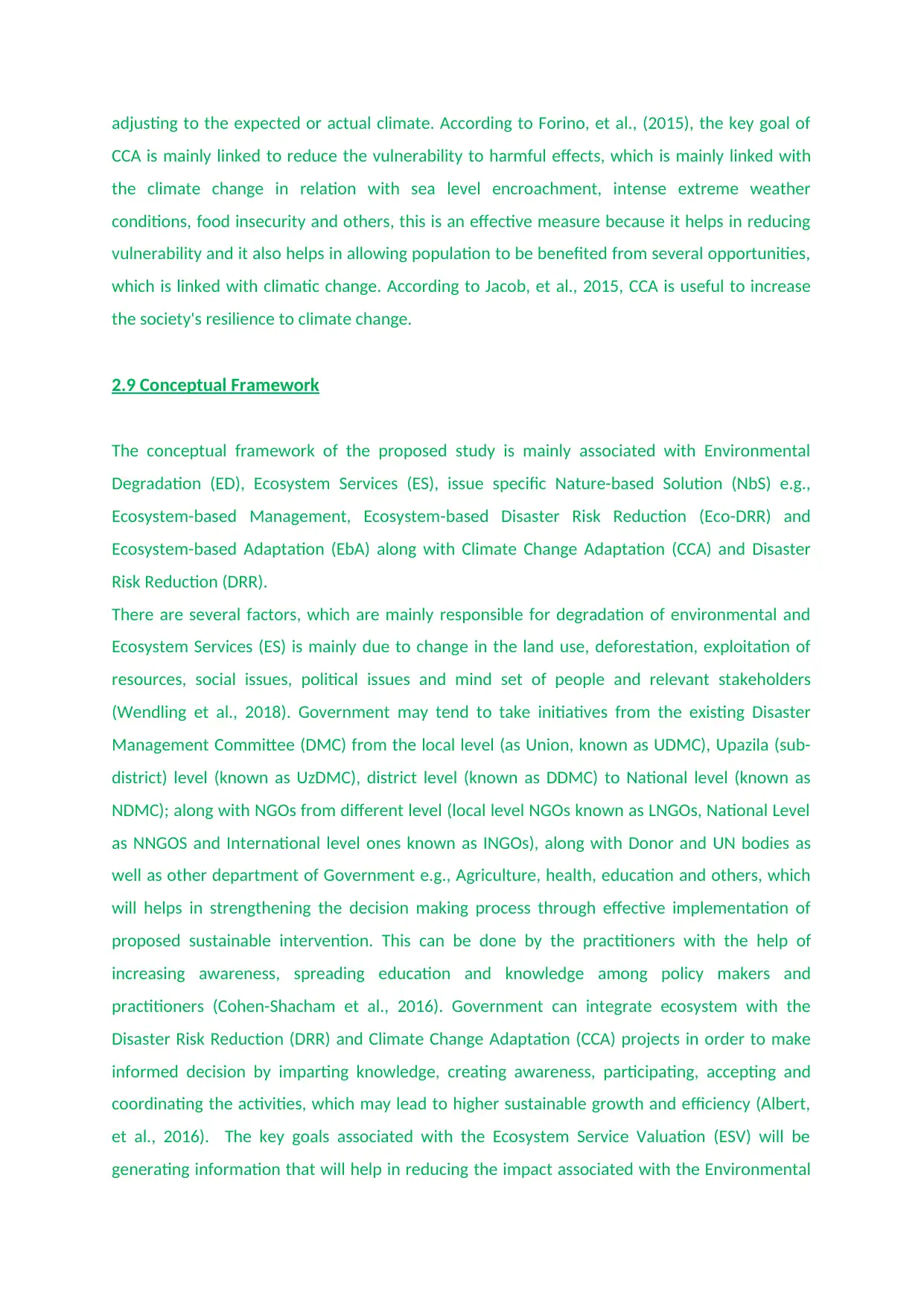
adjusting to the expected or actual climate. According to Forino, et al., (2015), the key goal of
CCA is mainly linked to reduce the vulnerability to harmful effects, which is mainly linked with
the climate change in relation with sea level encroachment, intense extreme weather
conditions, food insecurity and others, this is an effective measure because it helps in reducing
vulnerability and it also helps in allowing population to be benefited from several opportunities,
which is linked with climatic change. According to Jacob, et al., 2015, CCA is useful to increase
the society's resilience to climate change.
2.9 Conceptual Framework
The conceptual framework of the proposed study is mainly associated with Environmental
Degradation (ED), Ecosystem Services (ES), issue specific Nature-based Solution (NbS) e.g.,
Ecosystem-based Management, Ecosystem-based Disaster Risk Reduction (Eco-DRR) and
Ecosystem-based Adaptation (EbA) along with Climate Change Adaptation (CCA) and Disaster
Risk Reduction (DRR).
There are several factors, which are mainly responsible for degradation of environmental and
Ecosystem Services (ES) is mainly due to change in the land use, deforestation, exploitation of
resources, social issues, political issues and mind set of people and relevant stakeholders
(Wendling et al., 2018). Government may tend to take initiatives from the existing Disaster
Management Committee (DMC) from the local level (as Union, known as UDMC), Upazila (sub-
district) level (known as UzDMC), district level (known as DDMC) to National level (known as
NDMC); along with NGOs from different level (local level NGOs known as LNGOs, National Level
as NNGOS and International level ones known as INGOs), along with Donor and UN bodies as
well as other department of Government e.g., Agriculture, health, education and others, which
will helps in strengthening the decision making process through effective implementation of
proposed sustainable intervention. This can be done by the practitioners with the help of
increasing awareness, spreading education and knowledge among policy makers and
practitioners (Cohen-Shacham et al., 2016). Government can integrate ecosystem with the
Disaster Risk Reduction (DRR) and Climate Change Adaptation (CCA) projects in order to make
informed decision by imparting knowledge, creating awareness, participating, accepting and
coordinating the activities, which may lead to higher sustainable growth and efficiency (Albert,
et al., 2016). The key goals associated with the Ecosystem Service Valuation (ESV) will be
generating information that will help in reducing the impact associated with the Environmental
CCA is mainly linked to reduce the vulnerability to harmful effects, which is mainly linked with
the climate change in relation with sea level encroachment, intense extreme weather
conditions, food insecurity and others, this is an effective measure because it helps in reducing
vulnerability and it also helps in allowing population to be benefited from several opportunities,
which is linked with climatic change. According to Jacob, et al., 2015, CCA is useful to increase
the society's resilience to climate change.
2.9 Conceptual Framework
The conceptual framework of the proposed study is mainly associated with Environmental
Degradation (ED), Ecosystem Services (ES), issue specific Nature-based Solution (NbS) e.g.,
Ecosystem-based Management, Ecosystem-based Disaster Risk Reduction (Eco-DRR) and
Ecosystem-based Adaptation (EbA) along with Climate Change Adaptation (CCA) and Disaster
Risk Reduction (DRR).
There are several factors, which are mainly responsible for degradation of environmental and
Ecosystem Services (ES) is mainly due to change in the land use, deforestation, exploitation of
resources, social issues, political issues and mind set of people and relevant stakeholders
(Wendling et al., 2018). Government may tend to take initiatives from the existing Disaster
Management Committee (DMC) from the local level (as Union, known as UDMC), Upazila (sub-
district) level (known as UzDMC), district level (known as DDMC) to National level (known as
NDMC); along with NGOs from different level (local level NGOs known as LNGOs, National Level
as NNGOS and International level ones known as INGOs), along with Donor and UN bodies as
well as other department of Government e.g., Agriculture, health, education and others, which
will helps in strengthening the decision making process through effective implementation of
proposed sustainable intervention. This can be done by the practitioners with the help of
increasing awareness, spreading education and knowledge among policy makers and
practitioners (Cohen-Shacham et al., 2016). Government can integrate ecosystem with the
Disaster Risk Reduction (DRR) and Climate Change Adaptation (CCA) projects in order to make
informed decision by imparting knowledge, creating awareness, participating, accepting and
coordinating the activities, which may lead to higher sustainable growth and efficiency (Albert,
et al., 2016). The key goals associated with the Ecosystem Service Valuation (ESV) will be
generating information that will help in reducing the impact associated with the Environmental
Paraphrase This Document
Need a fresh take? Get an instant paraphrase of this document with our AI Paraphraser

Degradation (ED) which is mainly linked with the competitive resource exploitation (Cohen-
Shacham, et al., 2016).
Shacham, et al., 2016).
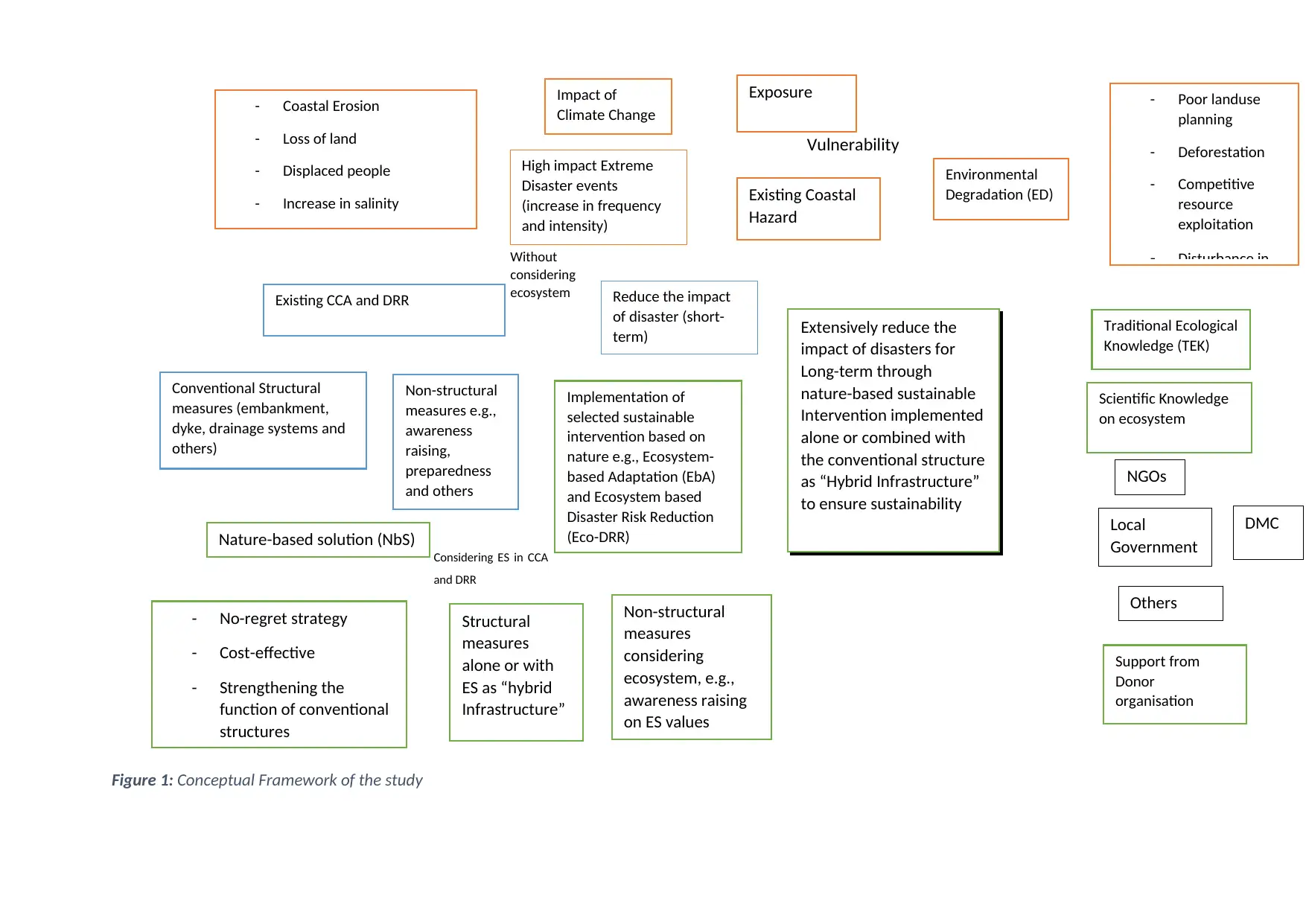
Figure 1: Conceptual Framework of the study
Environmental
Degradation (ED)Existing Coastal
Hazard
High impact Extreme
Disaster events
(increase in frequency
and intensity)
- Coastal Erosion
- Loss of land
- Displaced people
- Increase in salinity
Impact of
Climate Change
Exposure
Existing CCA and DRR
Nature-based solution (NbS)
Reduce the impact
of disaster (short-
term)
Implementation of
selected sustainable
intervention based on
nature e.g., Ecosystem-
based Adaptation (EbA)
and Ecosystem based
Disaster Risk Reduction
(Eco-DRR)
Extensively reduce the
impact of disasters for
Long-term through
nature-based sustainable
Intervention implemented
alone or combined with
the conventional structure
as “Hybrid Infrastructure”
to ensure sustainability
Structural
measures
alone or with
ES as “hybrid
Infrastructure”
Non-structural
measures e.g.,
awareness
raising,
preparedness
and others
Conventional Structural
measures (embankment,
dyke, drainage systems and
others)
- No-regret strategy
- Cost-effective
- Strengthening the
function of conventional
structures
Non-structural
measures
considering
ecosystem, e.g.,
awareness raising
on ES values
- Poor landuse
planning
- Deforestation
- Competitive
resource
exploitation
- Disturbance in
Scientific Knowledge
on ecosystem
Traditional Ecological
Knowledge (TEK)
Support from
Donor
organisation
DMC
Others
Local
Government
NGOs
Considering ES in CCA
and DRR
Vulnerability
Without
considering
ecosystem
Environmental
Degradation (ED)Existing Coastal
Hazard
High impact Extreme
Disaster events
(increase in frequency
and intensity)
- Coastal Erosion
- Loss of land
- Displaced people
- Increase in salinity
Impact of
Climate Change
Exposure
Existing CCA and DRR
Nature-based solution (NbS)
Reduce the impact
of disaster (short-
term)
Implementation of
selected sustainable
intervention based on
nature e.g., Ecosystem-
based Adaptation (EbA)
and Ecosystem based
Disaster Risk Reduction
(Eco-DRR)
Extensively reduce the
impact of disasters for
Long-term through
nature-based sustainable
Intervention implemented
alone or combined with
the conventional structure
as “Hybrid Infrastructure”
to ensure sustainability
Structural
measures
alone or with
ES as “hybrid
Infrastructure”
Non-structural
measures e.g.,
awareness
raising,
preparedness
and others
Conventional Structural
measures (embankment,
dyke, drainage systems and
others)
- No-regret strategy
- Cost-effective
- Strengthening the
function of conventional
structures
Non-structural
measures
considering
ecosystem, e.g.,
awareness raising
on ES values
- Poor landuse
planning
- Deforestation
- Competitive
resource
exploitation
- Disturbance in
Scientific Knowledge
on ecosystem
Traditional Ecological
Knowledge (TEK)
Support from
Donor
organisation
DMC
Others
Local
Government
NGOs
Considering ES in CCA
and DRR
Vulnerability
Without
considering
ecosystem
⊘ This is a preview!⊘
Do you want full access?
Subscribe today to unlock all pages.

Trusted by 1+ million students worldwide
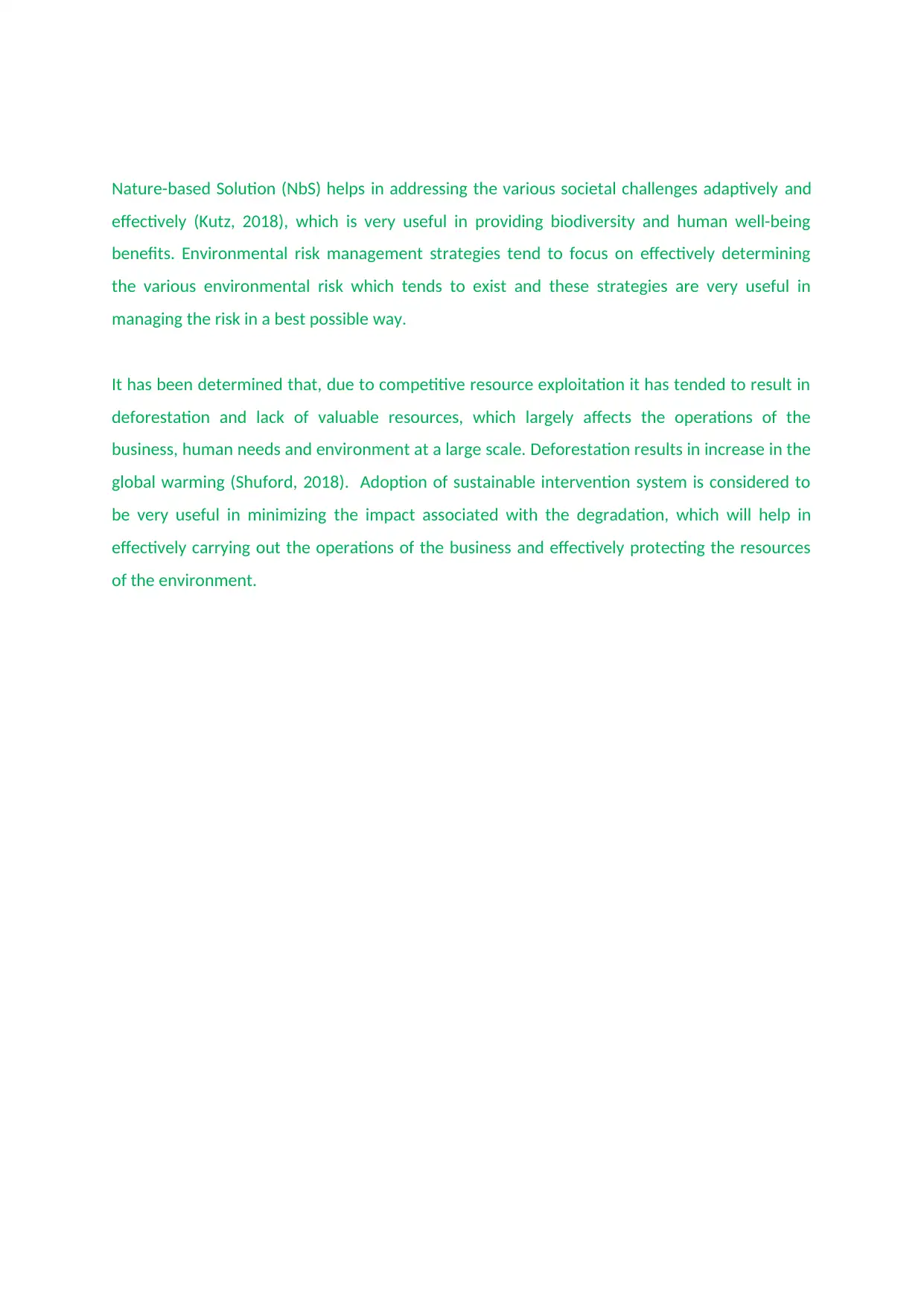
Nature-based Solution (NbS) helps in addressing the various societal challenges adaptively and
effectively (Kutz, 2018), which is very useful in providing biodiversity and human well-being
benefits. Environmental risk management strategies tend to focus on effectively determining
the various environmental risk which tends to exist and these strategies are very useful in
managing the risk in a best possible way.
It has been determined that, due to competitive resource exploitation it has tended to result in
deforestation and lack of valuable resources, which largely affects the operations of the
business, human needs and environment at a large scale. Deforestation results in increase in the
global warming (Shuford, 2018). Adoption of sustainable intervention system is considered to
be very useful in minimizing the impact associated with the degradation, which will help in
effectively carrying out the operations of the business and effectively protecting the resources
of the environment.
effectively (Kutz, 2018), which is very useful in providing biodiversity and human well-being
benefits. Environmental risk management strategies tend to focus on effectively determining
the various environmental risk which tends to exist and these strategies are very useful in
managing the risk in a best possible way.
It has been determined that, due to competitive resource exploitation it has tended to result in
deforestation and lack of valuable resources, which largely affects the operations of the
business, human needs and environment at a large scale. Deforestation results in increase in the
global warming (Shuford, 2018). Adoption of sustainable intervention system is considered to
be very useful in minimizing the impact associated with the degradation, which will help in
effectively carrying out the operations of the business and effectively protecting the resources
of the environment.
Paraphrase This Document
Need a fresh take? Get an instant paraphrase of this document with our AI Paraphraser
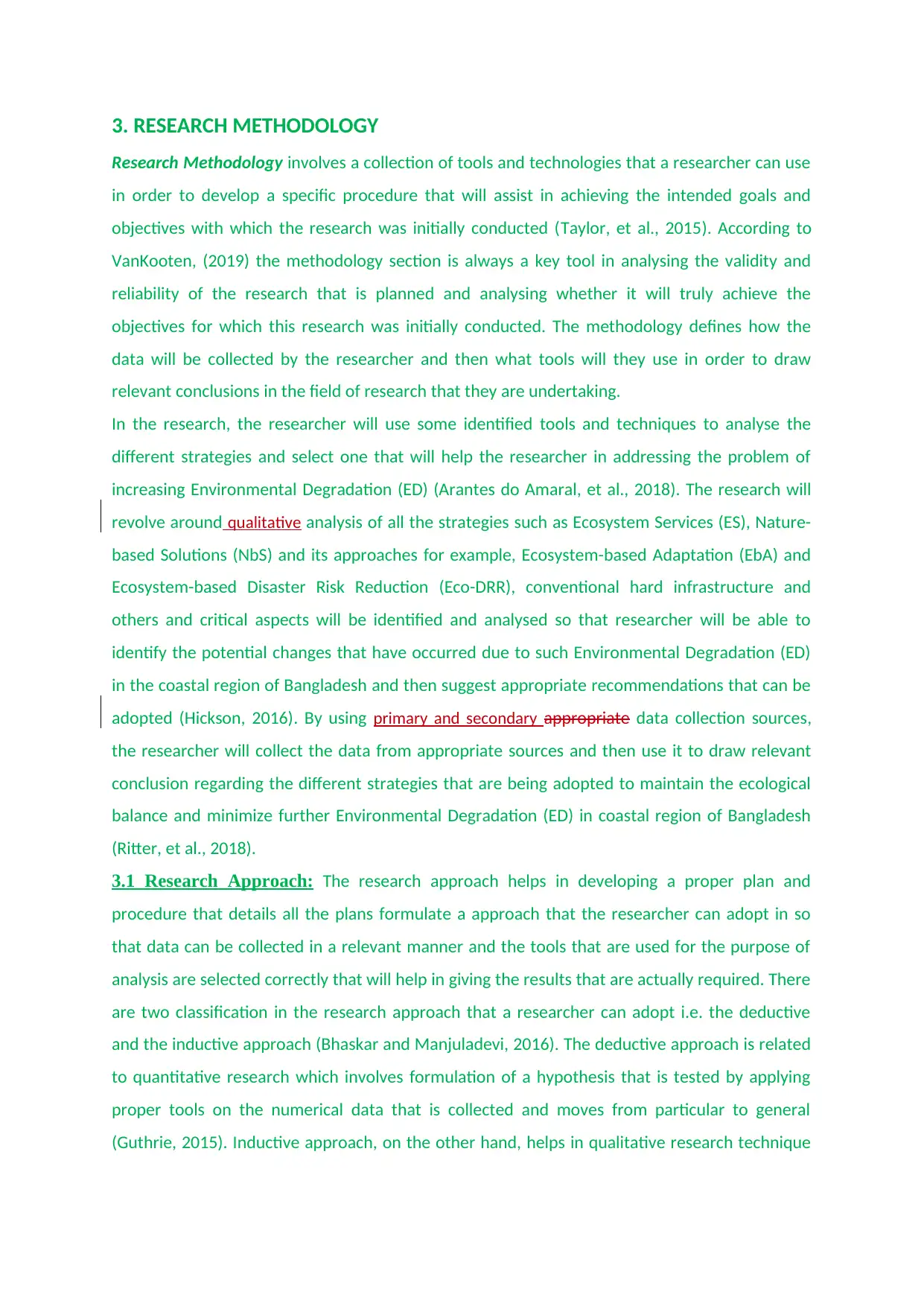
3. RESEARCH METHODOLOGY
Research Methodology involves a collection of tools and technologies that a researcher can use
in order to develop a specific procedure that will assist in achieving the intended goals and
objectives with which the research was initially conducted (Taylor, et al., 2015). According to
VanKooten, (2019) the methodology section is always a key tool in analysing the validity and
reliability of the research that is planned and analysing whether it will truly achieve the
objectives for which this research was initially conducted. The methodology defines how the
data will be collected by the researcher and then what tools will they use in order to draw
relevant conclusions in the field of research that they are undertaking.
In the research, the researcher will use some identified tools and techniques to analyse the
different strategies and select one that will help the researcher in addressing the problem of
increasing Environmental Degradation (ED) (Arantes do Amaral, et al., 2018). The research will
revolve around qualitative analysis of all the strategies such as Ecosystem Services (ES), Nature-
based Solutions (NbS) and its approaches for example, Ecosystem-based Adaptation (EbA) and
Ecosystem-based Disaster Risk Reduction (Eco-DRR), conventional hard infrastructure and
others and critical aspects will be identified and analysed so that researcher will be able to
identify the potential changes that have occurred due to such Environmental Degradation (ED)
in the coastal region of Bangladesh and then suggest appropriate recommendations that can be
adopted (Hickson, 2016). By using primary and secondary appropriate data collection sources,
the researcher will collect the data from appropriate sources and then use it to draw relevant
conclusion regarding the different strategies that are being adopted to maintain the ecological
balance and minimize further Environmental Degradation (ED) in coastal region of Bangladesh
(Ritter, et al., 2018).
3.1 Research Approach: The research approach helps in developing a proper plan and
procedure that details all the plans formulate a approach that the researcher can adopt in so
that data can be collected in a relevant manner and the tools that are used for the purpose of
analysis are selected correctly that will help in giving the results that are actually required. There
are two classification in the research approach that a researcher can adopt i.e. the deductive
and the inductive approach (Bhaskar and Manjuladevi, 2016). The deductive approach is related
to quantitative research which involves formulation of a hypothesis that is tested by applying
proper tools on the numerical data that is collected and moves from particular to general
(Guthrie, 2015). Inductive approach, on the other hand, helps in qualitative research technique
Research Methodology involves a collection of tools and technologies that a researcher can use
in order to develop a specific procedure that will assist in achieving the intended goals and
objectives with which the research was initially conducted (Taylor, et al., 2015). According to
VanKooten, (2019) the methodology section is always a key tool in analysing the validity and
reliability of the research that is planned and analysing whether it will truly achieve the
objectives for which this research was initially conducted. The methodology defines how the
data will be collected by the researcher and then what tools will they use in order to draw
relevant conclusions in the field of research that they are undertaking.
In the research, the researcher will use some identified tools and techniques to analyse the
different strategies and select one that will help the researcher in addressing the problem of
increasing Environmental Degradation (ED) (Arantes do Amaral, et al., 2018). The research will
revolve around qualitative analysis of all the strategies such as Ecosystem Services (ES), Nature-
based Solutions (NbS) and its approaches for example, Ecosystem-based Adaptation (EbA) and
Ecosystem-based Disaster Risk Reduction (Eco-DRR), conventional hard infrastructure and
others and critical aspects will be identified and analysed so that researcher will be able to
identify the potential changes that have occurred due to such Environmental Degradation (ED)
in the coastal region of Bangladesh and then suggest appropriate recommendations that can be
adopted (Hickson, 2016). By using primary and secondary appropriate data collection sources,
the researcher will collect the data from appropriate sources and then use it to draw relevant
conclusion regarding the different strategies that are being adopted to maintain the ecological
balance and minimize further Environmental Degradation (ED) in coastal region of Bangladesh
(Ritter, et al., 2018).
3.1 Research Approach: The research approach helps in developing a proper plan and
procedure that details all the plans formulate a approach that the researcher can adopt in so
that data can be collected in a relevant manner and the tools that are used for the purpose of
analysis are selected correctly that will help in giving the results that are actually required. There
are two classification in the research approach that a researcher can adopt i.e. the deductive
and the inductive approach (Bhaskar and Manjuladevi, 2016). The deductive approach is related
to quantitative research which involves formulation of a hypothesis that is tested by applying
proper tools on the numerical data that is collected and moves from particular to general
(Guthrie, 2015). Inductive approach, on the other hand, helps in qualitative research technique
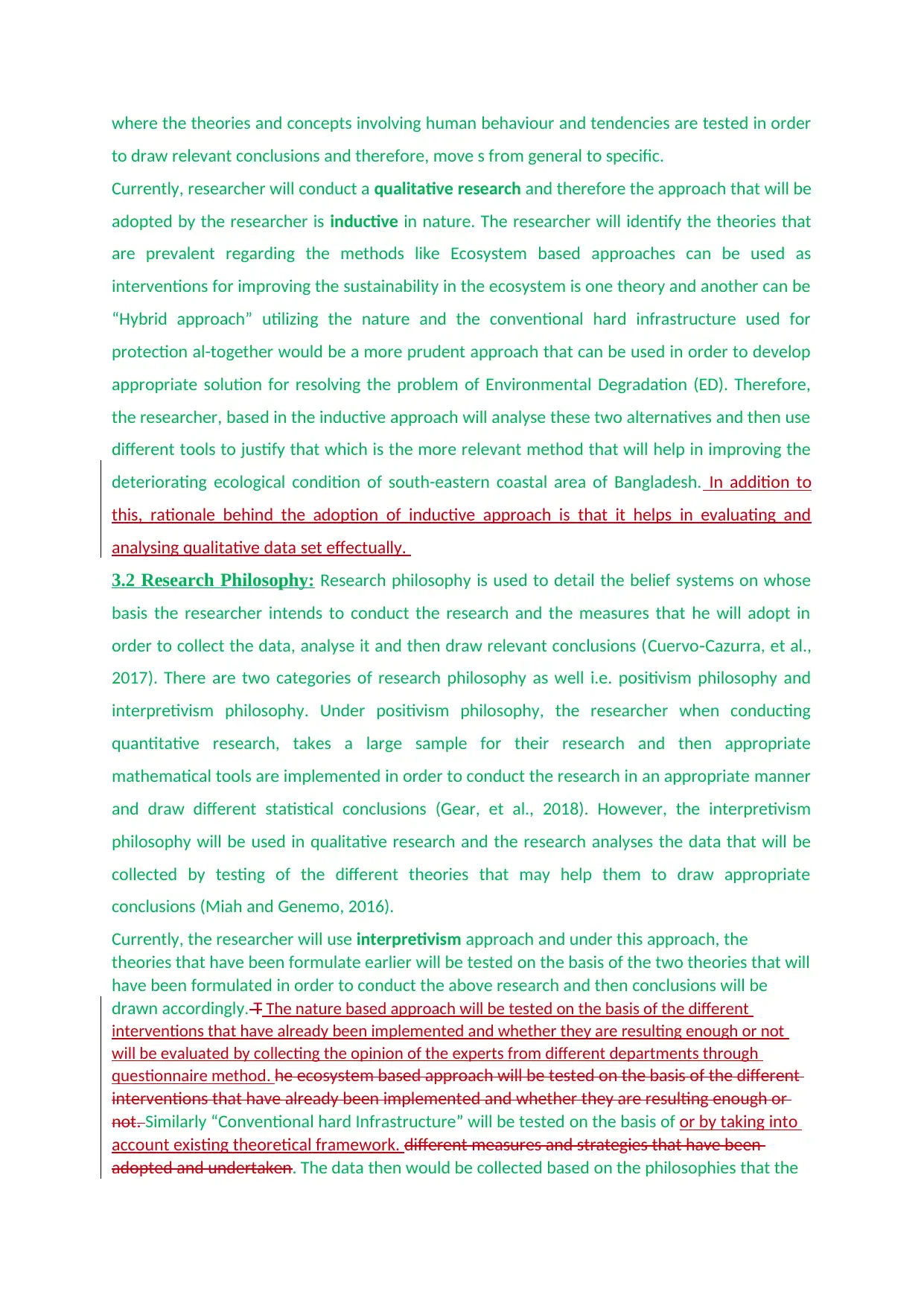
where the theories and concepts involving human behaviour and tendencies are tested in order
to draw relevant conclusions and therefore, move s from general to specific.
Currently, researcher will conduct a qualitative research and therefore the approach that will be
adopted by the researcher is inductive in nature. The researcher will identify the theories that
are prevalent regarding the methods like Ecosystem based approaches can be used as
interventions for improving the sustainability in the ecosystem is one theory and another can be
“Hybrid approach” utilizing the nature and the conventional hard infrastructure used for
protection al-together would be a more prudent approach that can be used in order to develop
appropriate solution for resolving the problem of Environmental Degradation (ED). Therefore,
the researcher, based in the inductive approach will analyse these two alternatives and then use
different tools to justify that which is the more relevant method that will help in improving the
deteriorating ecological condition of south-eastern coastal area of Bangladesh. In addition to
this, rationale behind the adoption of inductive approach is that it helps in evaluating and
analysing qualitative data set effectually.
3.2 Research Philosophy: Research philosophy is used to detail the belief systems on whose
basis the researcher intends to conduct the research and the measures that he will adopt in
order to collect the data, analyse it and then draw relevant conclusions (Cuervo Cazurra, et al.,‐
2017). There are two categories of research philosophy as well i.e. positivism philosophy and
interpretivism philosophy. Under positivism philosophy, the researcher when conducting
quantitative research, takes a large sample for their research and then appropriate
mathematical tools are implemented in order to conduct the research in an appropriate manner
and draw different statistical conclusions (Gear, et al., 2018). However, the interpretivism
philosophy will be used in qualitative research and the research analyses the data that will be
collected by testing of the different theories that may help them to draw appropriate
conclusions (Miah and Genemo, 2016).
Currently, the researcher will use interpretivism approach and under this approach, the
theories that have been formulate earlier will be tested on the basis of the two theories that will
have been formulated in order to conduct the above research and then conclusions will be
drawn accordingly. T The nature based approach will be tested on the basis of the different
interventions that have already been implemented and whether they are resulting enough or not
will be evaluated by collecting the opinion of the experts from different departments through
questionnaire method. he ecosystem based approach will be tested on the basis of the different
interventions that have already been implemented and whether they are resulting enough or
not. Similarly “Conventional hard Infrastructure” will be tested on the basis of or by taking into
account existing theoretical framework. different measures and strategies that have been
adopted and undertaken. The data then would be collected based on the philosophies that the
to draw relevant conclusions and therefore, move s from general to specific.
Currently, researcher will conduct a qualitative research and therefore the approach that will be
adopted by the researcher is inductive in nature. The researcher will identify the theories that
are prevalent regarding the methods like Ecosystem based approaches can be used as
interventions for improving the sustainability in the ecosystem is one theory and another can be
“Hybrid approach” utilizing the nature and the conventional hard infrastructure used for
protection al-together would be a more prudent approach that can be used in order to develop
appropriate solution for resolving the problem of Environmental Degradation (ED). Therefore,
the researcher, based in the inductive approach will analyse these two alternatives and then use
different tools to justify that which is the more relevant method that will help in improving the
deteriorating ecological condition of south-eastern coastal area of Bangladesh. In addition to
this, rationale behind the adoption of inductive approach is that it helps in evaluating and
analysing qualitative data set effectually.
3.2 Research Philosophy: Research philosophy is used to detail the belief systems on whose
basis the researcher intends to conduct the research and the measures that he will adopt in
order to collect the data, analyse it and then draw relevant conclusions (Cuervo Cazurra, et al.,‐
2017). There are two categories of research philosophy as well i.e. positivism philosophy and
interpretivism philosophy. Under positivism philosophy, the researcher when conducting
quantitative research, takes a large sample for their research and then appropriate
mathematical tools are implemented in order to conduct the research in an appropriate manner
and draw different statistical conclusions (Gear, et al., 2018). However, the interpretivism
philosophy will be used in qualitative research and the research analyses the data that will be
collected by testing of the different theories that may help them to draw appropriate
conclusions (Miah and Genemo, 2016).
Currently, the researcher will use interpretivism approach and under this approach, the
theories that have been formulate earlier will be tested on the basis of the two theories that will
have been formulated in order to conduct the above research and then conclusions will be
drawn accordingly. T The nature based approach will be tested on the basis of the different
interventions that have already been implemented and whether they are resulting enough or not
will be evaluated by collecting the opinion of the experts from different departments through
questionnaire method. he ecosystem based approach will be tested on the basis of the different
interventions that have already been implemented and whether they are resulting enough or
not. Similarly “Conventional hard Infrastructure” will be tested on the basis of or by taking into
account existing theoretical framework. different measures and strategies that have been
adopted and undertaken. The data then would be collected based on the philosophies that the
⊘ This is a preview!⊘
Do you want full access?
Subscribe today to unlock all pages.

Trusted by 1+ million students worldwide
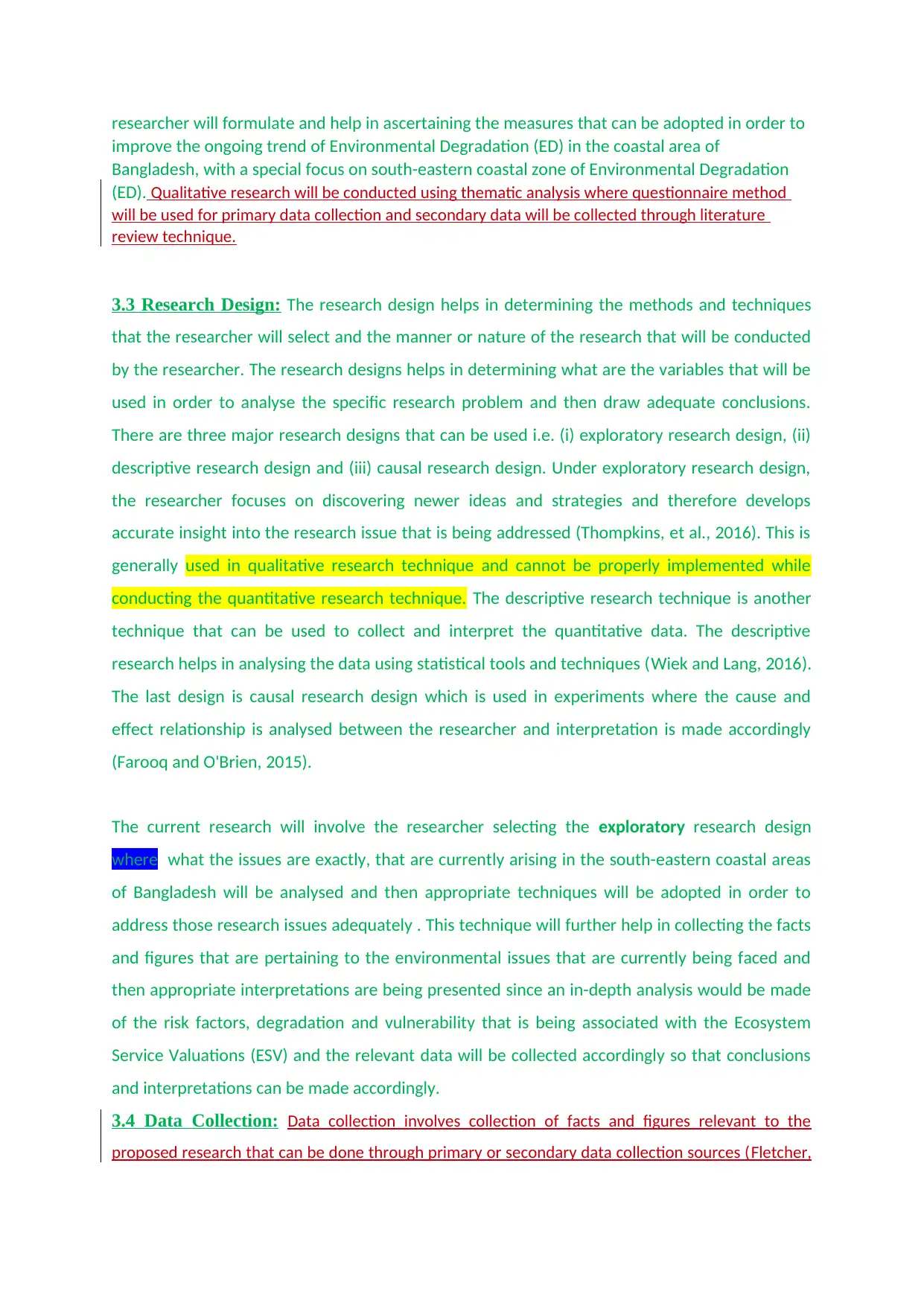
researcher will formulate and help in ascertaining the measures that can be adopted in order to
improve the ongoing trend of Environmental Degradation (ED) in the coastal area of
Bangladesh, with a special focus on south-eastern coastal zone of Environmental Degradation
(ED). Qualitative research will be conducted using thematic analysis where questionnaire method
will be used for primary data collection and secondary data will be collected through literature
review technique.
3.3 Research Design: The research design helps in determining the methods and techniques
that the researcher will select and the manner or nature of the research that will be conducted
by the researcher. The research designs helps in determining what are the variables that will be
used in order to analyse the specific research problem and then draw adequate conclusions.
There are three major research designs that can be used i.e. (i) exploratory research design, (ii)
descriptive research design and (iii) causal research design. Under exploratory research design,
the researcher focuses on discovering newer ideas and strategies and therefore develops
accurate insight into the research issue that is being addressed (Thompkins, et al., 2016). This is
generally used in qualitative research technique and cannot be properly implemented while
conducting the quantitative research technique. The descriptive research technique is another
technique that can be used to collect and interpret the quantitative data. The descriptive
research helps in analysing the data using statistical tools and techniques (Wiek and Lang, 2016).
The last design is causal research design which is used in experiments where the cause and
effect relationship is analysed between the researcher and interpretation is made accordingly
(Farooq and O'Brien, 2015).
The current research will involve the researcher selecting the exploratory research design
where what the issues are exactly, that are currently arising in the south-eastern coastal areas
of Bangladesh will be analysed and then appropriate techniques will be adopted in order to
address those research issues adequately . This technique will further help in collecting the facts
and figures that are pertaining to the environmental issues that are currently being faced and
then appropriate interpretations are being presented since an in-depth analysis would be made
of the risk factors, degradation and vulnerability that is being associated with the Ecosystem
Service Valuations (ESV) and the relevant data will be collected accordingly so that conclusions
and interpretations can be made accordingly.
3.4 Data Collection: Data collection involves collection of facts and figures relevant to the
proposed research that can be done through primary or secondary data collection sources (Fletcher,
improve the ongoing trend of Environmental Degradation (ED) in the coastal area of
Bangladesh, with a special focus on south-eastern coastal zone of Environmental Degradation
(ED). Qualitative research will be conducted using thematic analysis where questionnaire method
will be used for primary data collection and secondary data will be collected through literature
review technique.
3.3 Research Design: The research design helps in determining the methods and techniques
that the researcher will select and the manner or nature of the research that will be conducted
by the researcher. The research designs helps in determining what are the variables that will be
used in order to analyse the specific research problem and then draw adequate conclusions.
There are three major research designs that can be used i.e. (i) exploratory research design, (ii)
descriptive research design and (iii) causal research design. Under exploratory research design,
the researcher focuses on discovering newer ideas and strategies and therefore develops
accurate insight into the research issue that is being addressed (Thompkins, et al., 2016). This is
generally used in qualitative research technique and cannot be properly implemented while
conducting the quantitative research technique. The descriptive research technique is another
technique that can be used to collect and interpret the quantitative data. The descriptive
research helps in analysing the data using statistical tools and techniques (Wiek and Lang, 2016).
The last design is causal research design which is used in experiments where the cause and
effect relationship is analysed between the researcher and interpretation is made accordingly
(Farooq and O'Brien, 2015).
The current research will involve the researcher selecting the exploratory research design
where what the issues are exactly, that are currently arising in the south-eastern coastal areas
of Bangladesh will be analysed and then appropriate techniques will be adopted in order to
address those research issues adequately . This technique will further help in collecting the facts
and figures that are pertaining to the environmental issues that are currently being faced and
then appropriate interpretations are being presented since an in-depth analysis would be made
of the risk factors, degradation and vulnerability that is being associated with the Ecosystem
Service Valuations (ESV) and the relevant data will be collected accordingly so that conclusions
and interpretations can be made accordingly.
3.4 Data Collection: Data collection involves collection of facts and figures relevant to the
proposed research that can be done through primary or secondary data collection sources (Fletcher,
Paraphrase This Document
Need a fresh take? Get an instant paraphrase of this document with our AI Paraphraser
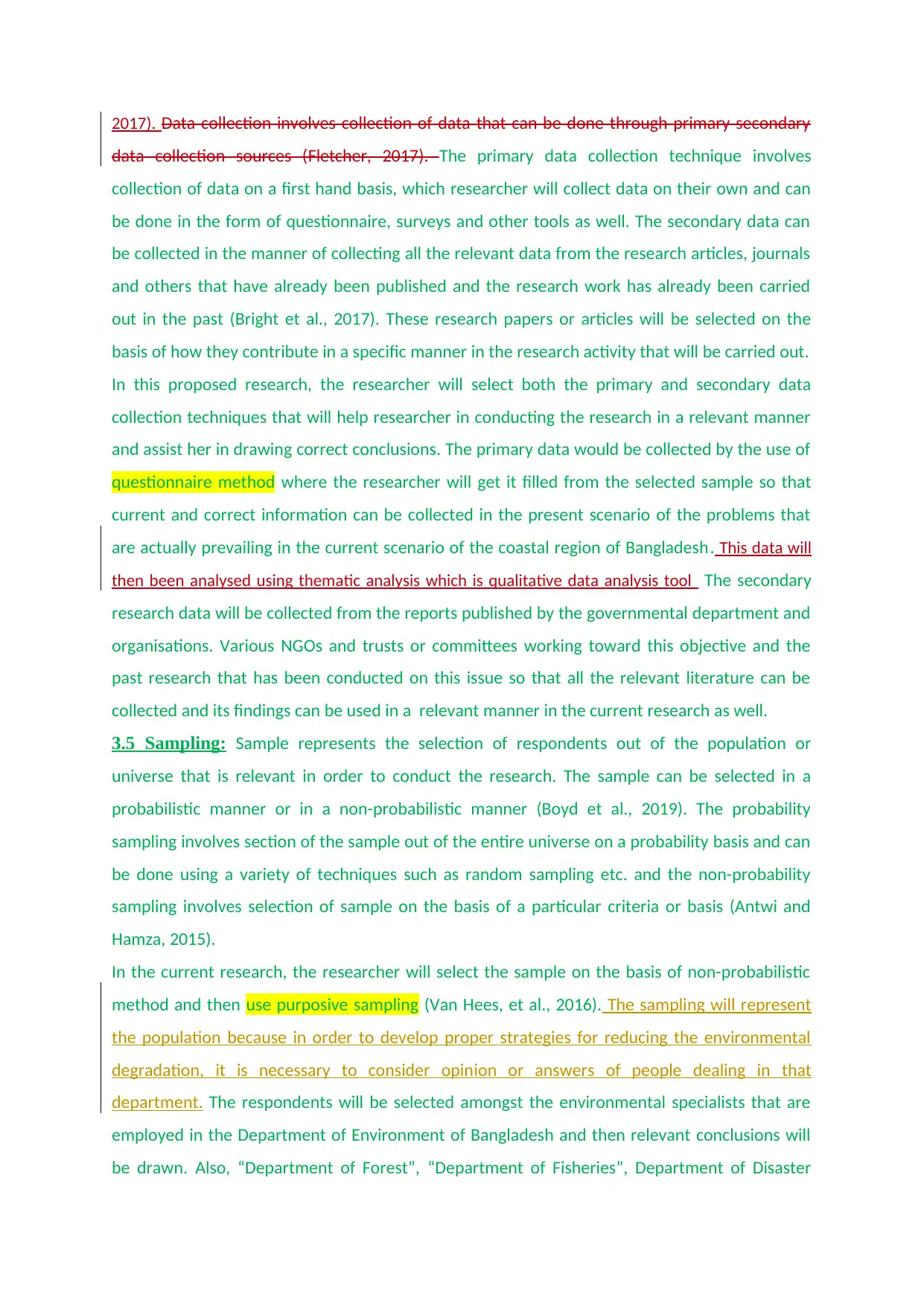
2017). Data collection involves collection of data that can be done through primary secondary
data collection sources (Fletcher, 2017). The primary data collection technique involves
collection of data on a first hand basis, which researcher will collect data on their own and can
be done in the form of questionnaire, surveys and other tools as well. The secondary data can
be collected in the manner of collecting all the relevant data from the research articles, journals
and others that have already been published and the research work has already been carried
out in the past (Bright et al., 2017). These research papers or articles will be selected on the
basis of how they contribute in a specific manner in the research activity that will be carried out.
In this proposed research, the researcher will select both the primary and secondary data
collection techniques that will help researcher in conducting the research in a relevant manner
and assist her in drawing correct conclusions. The primary data would be collected by the use of
questionnaire method where the researcher will get it filled from the selected sample so that
current and correct information can be collected in the present scenario of the problems that
are actually prevailing in the current scenario of the coastal region of Bangladesh. This data will
then been analysed using thematic analysis which is qualitative data analysis tool The secondary
research data will be collected from the reports published by the governmental department and
organisations. Various NGOs and trusts or committees working toward this objective and the
past research that has been conducted on this issue so that all the relevant literature can be
collected and its findings can be used in a relevant manner in the current research as well.
3.5 Sampling: Sample represents the selection of respondents out of the population or
universe that is relevant in order to conduct the research. The sample can be selected in a
probabilistic manner or in a non-probabilistic manner (Boyd et al., 2019). The probability
sampling involves section of the sample out of the entire universe on a probability basis and can
be done using a variety of techniques such as random sampling etc. and the non-probability
sampling involves selection of sample on the basis of a particular criteria or basis (Antwi and
Hamza, 2015).
In the current research, the researcher will select the sample on the basis of non-probabilistic
method and then use purposive sampling (Van Hees, et al., 2016). The sampling will represent
the population because in order to develop proper strategies for reducing the environmental
degradation, it is necessary to consider opinion or answers of people dealing in that
department. The respondents will be selected amongst the environmental specialists that are
employed in the Department of Environment of Bangladesh and then relevant conclusions will
be drawn. Also, “Department of Forest”, “Department of Fisheries”, Department of Disaster
data collection sources (Fletcher, 2017). The primary data collection technique involves
collection of data on a first hand basis, which researcher will collect data on their own and can
be done in the form of questionnaire, surveys and other tools as well. The secondary data can
be collected in the manner of collecting all the relevant data from the research articles, journals
and others that have already been published and the research work has already been carried
out in the past (Bright et al., 2017). These research papers or articles will be selected on the
basis of how they contribute in a specific manner in the research activity that will be carried out.
In this proposed research, the researcher will select both the primary and secondary data
collection techniques that will help researcher in conducting the research in a relevant manner
and assist her in drawing correct conclusions. The primary data would be collected by the use of
questionnaire method where the researcher will get it filled from the selected sample so that
current and correct information can be collected in the present scenario of the problems that
are actually prevailing in the current scenario of the coastal region of Bangladesh. This data will
then been analysed using thematic analysis which is qualitative data analysis tool The secondary
research data will be collected from the reports published by the governmental department and
organisations. Various NGOs and trusts or committees working toward this objective and the
past research that has been conducted on this issue so that all the relevant literature can be
collected and its findings can be used in a relevant manner in the current research as well.
3.5 Sampling: Sample represents the selection of respondents out of the population or
universe that is relevant in order to conduct the research. The sample can be selected in a
probabilistic manner or in a non-probabilistic manner (Boyd et al., 2019). The probability
sampling involves section of the sample out of the entire universe on a probability basis and can
be done using a variety of techniques such as random sampling etc. and the non-probability
sampling involves selection of sample on the basis of a particular criteria or basis (Antwi and
Hamza, 2015).
In the current research, the researcher will select the sample on the basis of non-probabilistic
method and then use purposive sampling (Van Hees, et al., 2016). The sampling will represent
the population because in order to develop proper strategies for reducing the environmental
degradation, it is necessary to consider opinion or answers of people dealing in that
department. The respondents will be selected amongst the environmental specialists that are
employed in the Department of Environment of Bangladesh and then relevant conclusions will
be drawn. Also, “Department of Forest”, “Department of Fisheries”, Department of Disaster
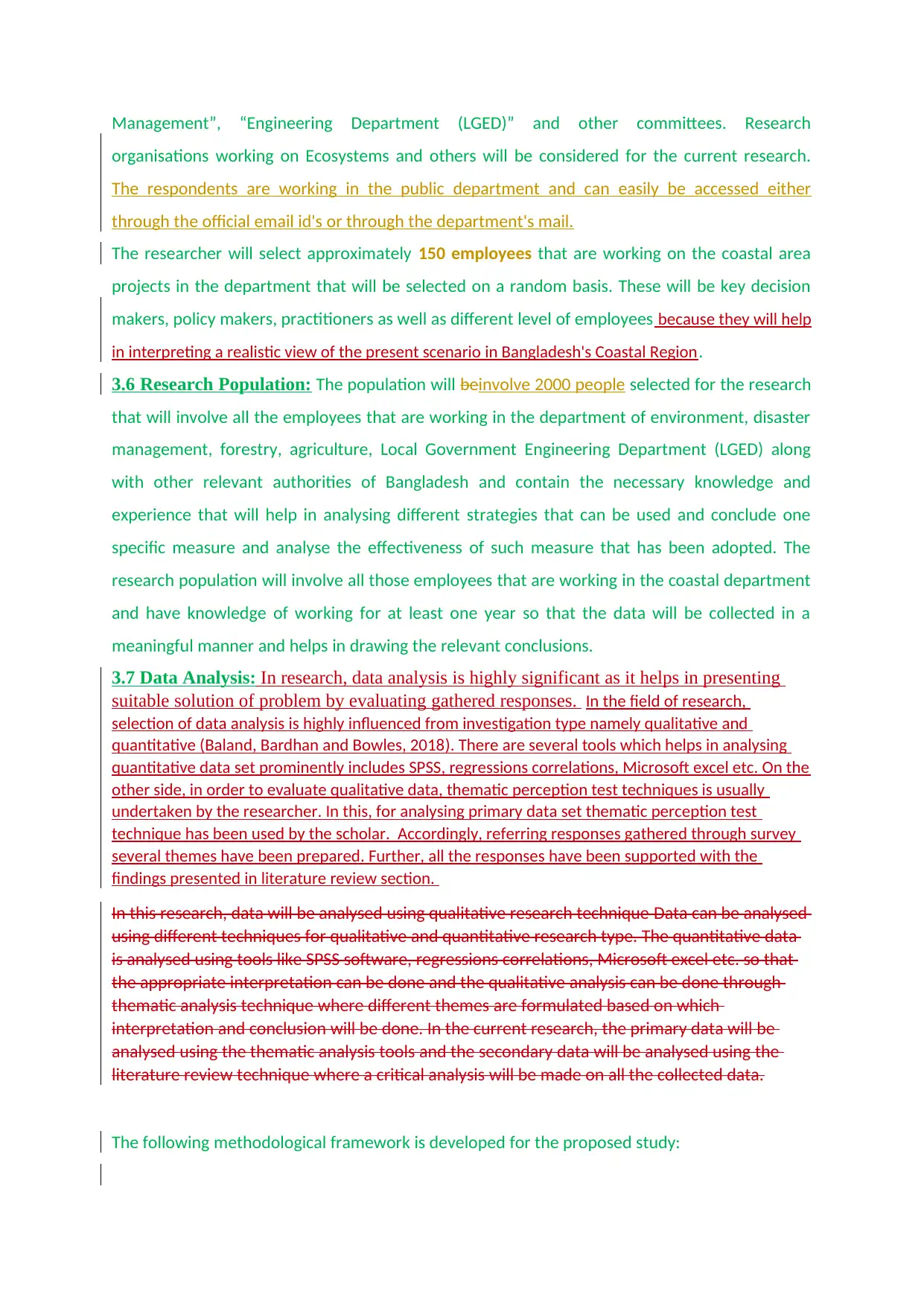
Management”, “Engineering Department (LGED)” and other committees. Research
organisations working on Ecosystems and others will be considered for the current research.
The respondents are working in the public department and can easily be accessed either
through the official email id's or through the department's mail.
The researcher will select approximately 150 employees that are working on the coastal area
projects in the department that will be selected on a random basis. These will be key decision
makers, policy makers, practitioners as well as different level of employees because they will help
in interpreting a realistic view of the present scenario in Bangladesh's Coastal Region.
3.6 Research Population: The population will beinvolve 2000 people selected for the research
that will involve all the employees that are working in the department of environment, disaster
management, forestry, agriculture, Local Government Engineering Department (LGED) along
with other relevant authorities of Bangladesh and contain the necessary knowledge and
experience that will help in analysing different strategies that can be used and conclude one
specific measure and analyse the effectiveness of such measure that has been adopted. The
research population will involve all those employees that are working in the coastal department
and have knowledge of working for at least one year so that the data will be collected in a
meaningful manner and helps in drawing the relevant conclusions.
3.7 Data Analysis: In research, data analysis is highly significant as it helps in presenting
suitable solution of problem by evaluating gathered responses. In the field of research,
selection of data analysis is highly influenced from investigation type namely qualitative and
quantitative (Baland, Bardhan and Bowles, 2018). There are several tools which helps in analysing
quantitative data set prominently includes SPSS, regressions correlations, Microsoft excel etc. On the
other side, in order to evaluate qualitative data, thematic perception test techniques is usually
undertaken by the researcher. In this, for analysing primary data set thematic perception test
technique has been used by the scholar. Accordingly, referring responses gathered through survey
several themes have been prepared. Further, all the responses have been supported with the
findings presented in literature review section.
In this research, data will be analysed using qualitative research technique Data can be analysed
using different techniques for qualitative and quantitative research type. The quantitative data
is analysed using tools like SPSS software, regressions correlations, Microsoft excel etc. so that
the appropriate interpretation can be done and the qualitative analysis can be done through
thematic analysis technique where different themes are formulated based on which
interpretation and conclusion will be done. In the current research, the primary data will be
analysed using the thematic analysis tools and the secondary data will be analysed using the
literature review technique where a critical analysis will be made on all the collected data.
The following methodological framework is developed for the proposed study:
organisations working on Ecosystems and others will be considered for the current research.
The respondents are working in the public department and can easily be accessed either
through the official email id's or through the department's mail.
The researcher will select approximately 150 employees that are working on the coastal area
projects in the department that will be selected on a random basis. These will be key decision
makers, policy makers, practitioners as well as different level of employees because they will help
in interpreting a realistic view of the present scenario in Bangladesh's Coastal Region.
3.6 Research Population: The population will beinvolve 2000 people selected for the research
that will involve all the employees that are working in the department of environment, disaster
management, forestry, agriculture, Local Government Engineering Department (LGED) along
with other relevant authorities of Bangladesh and contain the necessary knowledge and
experience that will help in analysing different strategies that can be used and conclude one
specific measure and analyse the effectiveness of such measure that has been adopted. The
research population will involve all those employees that are working in the coastal department
and have knowledge of working for at least one year so that the data will be collected in a
meaningful manner and helps in drawing the relevant conclusions.
3.7 Data Analysis: In research, data analysis is highly significant as it helps in presenting
suitable solution of problem by evaluating gathered responses. In the field of research,
selection of data analysis is highly influenced from investigation type namely qualitative and
quantitative (Baland, Bardhan and Bowles, 2018). There are several tools which helps in analysing
quantitative data set prominently includes SPSS, regressions correlations, Microsoft excel etc. On the
other side, in order to evaluate qualitative data, thematic perception test techniques is usually
undertaken by the researcher. In this, for analysing primary data set thematic perception test
technique has been used by the scholar. Accordingly, referring responses gathered through survey
several themes have been prepared. Further, all the responses have been supported with the
findings presented in literature review section.
In this research, data will be analysed using qualitative research technique Data can be analysed
using different techniques for qualitative and quantitative research type. The quantitative data
is analysed using tools like SPSS software, regressions correlations, Microsoft excel etc. so that
the appropriate interpretation can be done and the qualitative analysis can be done through
thematic analysis technique where different themes are formulated based on which
interpretation and conclusion will be done. In the current research, the primary data will be
analysed using the thematic analysis tools and the secondary data will be analysed using the
literature review technique where a critical analysis will be made on all the collected data.
The following methodological framework is developed for the proposed study:
⊘ This is a preview!⊘
Do you want full access?
Subscribe today to unlock all pages.

Trusted by 1+ million students worldwide
1 out of 24
Related Documents
Your All-in-One AI-Powered Toolkit for Academic Success.
+13062052269
info@desklib.com
Available 24*7 on WhatsApp / Email
![[object Object]](/_next/static/media/star-bottom.7253800d.svg)
Unlock your academic potential
Copyright © 2020–2025 A2Z Services. All Rights Reserved. Developed and managed by ZUCOL.



